Dollar Remains Strong
The dollar made gains against most currencies during Friday 10/04, supported by the speech by Federal Reserve Chairman William Dudley, who said Wednesday that the timing of an interest rate hike depends on economic data and added that a rate hike in June could still be possible if the labor market rebound remains strong. In addition, the Federal Reserve also showed that several authorities believe that the economic scenario is likely to justify an increase in interest rates in June.
The dollar was also boosted after the US Department of Labor reported on Thursday that the number of people applying for unemployment benefits last week rose less than expected.
EUR / USD fell 0.60% to 1.0596, even though previous data showed that French industrial production was full in February. A separate report showed that industrial production in Spain grew at an annualized rate of 0.6% in February, after a 0.1% gain in January, whose value was revised from an earlier estimate of 0.4%. The pound was also lower, with GBP / USD sliding 0.72% to 1.4605. In a report, the National Statistics Office said the UK’s industrial production rose 0.4% in February, in line with expectations. On an annual basis, UK industrial production rose 1.1% in February, disappointing expectations for a 1.3% gain.
Elsewhere, the dollar fell against the yen, with USD / JPY sliding 0.23% to 120.30, but higher against the Swiss franc, with USD / CHF rising 0.34% to 0.9808.
The Australian and New Zealand dollars remained weaker, with AUD / USD sliding 0.46% to 0.7656 and NZD / USD decreasing 0.49% to 0.7529.
Meanwhile, USD / CAD rose 0.30% to 1.2615 after data showed that the number of people employed in Canada increased by 28,700 last month, exceeding expectations for a decline of 100 and after a fall of 1,000 in February. The report also showed that Canada’s unemployment rate remained at 6.8% in March, in line with expectations.

